(This is an English translation of the original Japanese article.
The publication date refers to that of the Japanese version,
which differs from the upload date of the English version.)
Control of spider mites, a harmful pest of fruit trees such as apples and mandarins, has relied heavily on acaricides, chemical pesticides designed specifically to kill spider mites. However, spider mites have a strong tendency to develop resistance to these chemicals, and the conventional approach of relying on the supply of new acaricides is reaching its limits. As a result, there is a growing interest in a pest management system called "Double natural enemy" or "Dabuten" in Japanese abbreviation for "double tenteki (natural enemy)", which utilizes naturally occurring indigenous natural enemies in orchards and introduces a commercially available natural enemy as a biological pesticide when indigenous natural enemies are insufficient. This pest management system aims to reduce the frequency of labor-intensive acaricide applications while preserving the diversity of beneficial insects, including indigenous natural enemies, and demonstrating excellent environmental conservation practices.
Commendation by Minister of Environment for Climate Change Action
The Double-tenteki Consortium, a research group, has developed a method using natural enemies to control spider mites, which are pests of fruit trees. As a result of this achievement, they were awarded the Climate Action Award (Development and Commercialization Category) at the Climate Change Action Minister's Awards hosted by the Ministry of the Environment in the 3rd year of the Reiwa era.
Why is the use of natural enemies an adaptation measure to climate change? As global warming progresses, there is a concern about the increased frequency and duration of spider mite infestations, which cause widespread damage to fruit production. However, this method can control the pest damage while also preserving the biodiversity of indigenous natural enemies and other organisms. This aspect has been highly praised in recognition of their efforts.
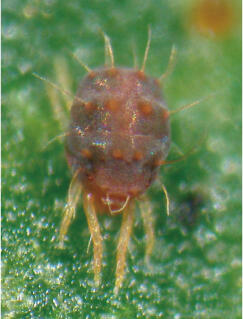
Photo 1: Citrus spider mite
(provided by NARO)
What is "Dabuten"?
"Dabuten" is an abbreviation for "double tenteki". It was coined due to the use of two types of natural enemies, referring to the indigenous natural enemies living in orchards and the commercially available natural enemies released in orchards to supplement the effectiveness of the indigenous ones. The key player in this system is a predatory mite belonging to the family Phytoseiidae. Among the indigenous species, there are also generalists with a broad diet that includes not only spider mites but also pollen and nectar (Photo 2).
In Dabuten Pest Control System, efforts are made to preserve the habitat and food sources for these natural enemies by maintaining as much ground cover as possible in orchards (Photo 3). Additionally, chemical pesticide options with minimal impact on the indigenous natural enemies are chosen for pest and disease control to avoid harming them. Furthermore, given the time lag between the increase in spider mites and the increase in predatory mites, the simultaneous use of acaricides is also considered during periods or locations when/where spider mite populations are increasing rapidly.
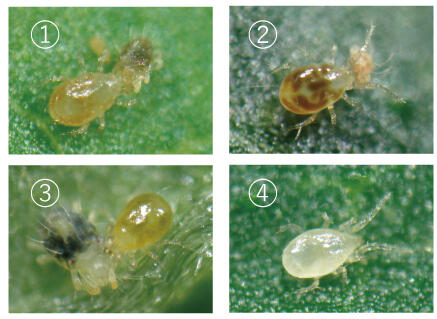
Photo 2: Phytoseiid mites
①Typhlodromus vulgaris ②Amblyseius eharai
③Amblyseius tsugawai④Euseius sojaensis
(provided by NARO)
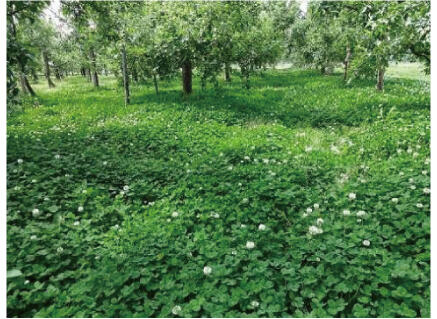
Photo 3: Clover in an apple orchard that serves as a home for indigenous natural enemies
(provided by Akita Fruit-Tree Experiment Station)
Predatory mite sachet + Banker-SheetTM
The predatory mite release method used in Dabuten system was mainly developed by organizations such as the National Agriculture and Food Research Organization and Ishihara Sangyo Kaisha, Ltd. In this method, sachets containing predatory mites are placed inside protective objects named "Banker-SheetTM" (Photo 4). The assembly process involves sandwiching a predatory mite sachet with black felt, which serves as an oviposition site, inserting it into a Banker-SheetTM body, and adding a few gel-like moisture-retaining materials. Approximately 100 sets can be completed in about 30 minutes. In orchards, these sets are suspended from branches or tied to a trunk for installation (Photo 5). Banker-SheetTM is used to protect the sachet from rain and pesticide applications while maintaining suitable environmental conditions. Released predatory mites will prey on spider mites for approximately 1 to 2 months.
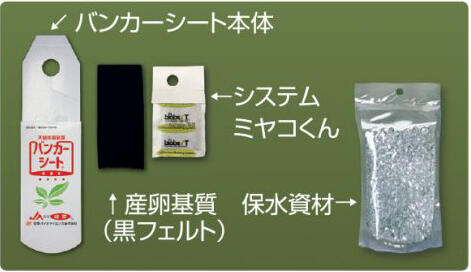
Photo 4 : Miyako-bankerTM is composed of a Neoseiulus californicus sachet (System Miyako-kunTM), black felt, gel-like moisture-retaining materials and Banker-SheetTM (provided by ISK Biosciences K.K.)
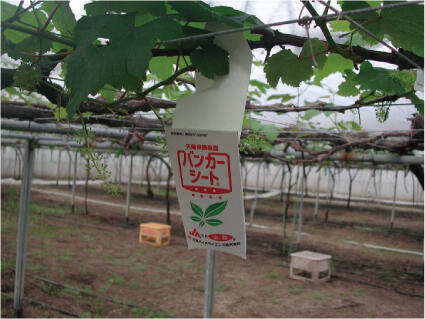
Photo 5 : Banker-SheetTM in a vineyard
(provided by Shimane Agricultural Technology Center)
Demonstrating results in various places such as Akita, Chiba, and Saga
The Dabuten Pest Control System has achieved success in various regions through demonstration trials, including apple orchards in Akita Prefecture, cherry orchards in Yamagata Prefecture, pear orchards in Chiba Prefecture, greenhouse grape vineyards in Shimane Prefecture, and mandarin orange orchards in Saga Prefecture.
For example, in a trial conducted by Chiba Prefectural Agriculture and Forestry Research Center, Dabuten system was implemented in pear orchards where indigenous predatory mites were established. The Miyako-bankerTM releasing Neoseiulus californicus, was installed with four sets per tree from June to July. As a result, the number of spider mites was effectively controlled, comparable to using acaricides. Based on these results, Chiba Prefecture developed the "IPM Manual for Spider Mite Control in Japanese Pear Using Predatory Mites" in 2020.
In addition, Dabuten system has demonstrated its effectiveness in greenhouse mandarin orange cultivation in Saga Prefecture. According to trials conducted by the Saga Uwaba Agricultural Center, the Swaru-bankerTM, releasing Amblyseius swirskii, was installed with one to two sets per tree. This successfully suppressed the population of spider mites while reducing the labor-intensive application of acaricides. In the service area of JA Karatsu of Saga Prefecture, which is known for its extensive greenhouse mandarin orange cultivation, approximately 20% of growers have adopted Dabuten system.
The Double-tenteki Consortium has summarized these achievements and published the "New Manual for Spider Mite Control in Fruit Trees: Dabuten Pest Control System" (3rd edition) in March 2021. The development of this manual is expected to promote the adoption of the Dabuten system in fruit-producing regions.
Project name
Research Program on Development of Innovative Technology(Development Research Stage)
Project period
FY2016 to 2018
Title
Establishment of a sustainable spider mite control system for fruit trees using indigenous natural enemies and natural enemy formulations
Leading research institutes
Institute of Fruit Tree and Tea Science, NARO (NIFTS), Akita Fruit-Tree Experiment Station, Yamagata Integrated Agricultural Research Center, Chiba Prefectural Agriculture and Forestry Research Center, Shimane Agricultural Technology Center, Saga Uwaba Agricultural Center, Ishihara Sangyo Kaisha, Ltd., ISK Biosciences K.K., Daikyo Giken-Kogyo Co.,Ltd., Utsunomiya University School of Agriculture
